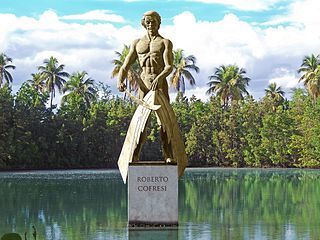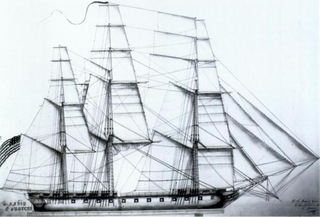
Roberto Cofresí y Ramírez de Arellano, better known as El Pirata Cofresí, was a pirate from Puerto Rico. He was born into a noble family, but the political and economic difficulties faced by the island as a colony of the Spanish Empire during the Latin American wars of independence meant that his household was poor. Cofresí worked at sea from an early age which familiarized him with the region's geography, but it provided only a modest salary, and he eventually decided to abandon the sailor's life and became a pirate. He had previous links to land-based criminal activities, but the reason for Cofresí's change of vocation is unknown; historians speculate that he may have worked as a privateer aboard El Scipión, a ship owned by one of his cousins.

USS Grampus was a schooner in the United States Navy. She was the first U.S. Navy ship to be named for the Grampus griseus, also known as Risso's dolphin.

The third USS Hornet was a brig-rigged sloop-of-war in the United States Navy. During the War of 1812, she was the first U.S. Navy ship to capture a British privateer.
Sea Gull was a steamship in the United States Navy. She was the second steamship of the United States Navy and the first to serve actively as a warship.

The first USS Shark was a schooner in the United States Navy. Built in the Washington Navy Yard to the designs of Henry Steers, Shark was launched on 17 May 1821. On 11 May 1821, Matthew C. Perry was ordered to take command of Shark, and the ship was ready to receive her crew on 2 June 1821.
Commodore John Thomas Newton was an officer in the United States Navy who commanded several ships over a period of decades, undertaking missions in the Caribbean and leading the first crossing of the Atlantic by an American steam-powered warship. He was court-martialed following a fire that destroyed that vessel, but his suspension from service was remitted by President John Tyler, after which Newton commanded Pensacola Navy Yard and the Home Squadron for periods. He died while serving in his last post as president of a Naval Court of Inquiry.

The term Mosquito Fleet has had a variety of naval and commercial uses around the world.

USS Topeka (PG-35) was a gunboat of the United States Navy.
Diabolito or Little Devil was a 19th-century Cuban pirate. One of the more violent of the era, he engaged the United States Navy and Revenue Marine Service several times. Being one of the main fugitives hunted and pursued later by American Naval forces during the West Indies anti-piracy operations of the United States in the Caribbean during the 1820s. He was also known for having a mixed-race crew, which included “English, Frenchmen, Spaniards, Mulattoes, and Negroes.”
USS Torch was a schooner—heavily armed with guns and carronades—in the United States Navy during the early years of the republic. She was built for service in the War of 1812, but did not see service until the Barbary Wars when she was sent with the American fleet to the Mediterranean to force an end to piracy of American ships.
USS Decoy was a schooner in the United States Navy during the 1820s. Decoy was purchased 27 December 1822 by Commodore David Porter in New York under the name Zodiac.
USS Beagle was a schooner in the United States Navy during the 1820s. Beagle was purchased by the Navy on 20 December 1822 in Baltimore, Maryland, and commissioned early in 1823, Lieutenant John T. Newton in command.

The capture of the sloop Anne was the result of a naval campaign carried out by an alliance between the Spanish Empire forces in Puerto Rico, the Danish government in Saint Thomas and the United States Navy. The powers pursued Roberto Cofresí's pirate flotilla in March 1825 because of the economic losses suffered by the parties to the pirates, as well as diplomatic concerns caused by their use of the flags of Spain and Gran Colombia which menaced the fragile peace between the naval powers. Several of those involved had been attacked by the freebooters. Among the diplomatic concerns caused by Cofresí was a robbery carried out by several of his subordinates, the catalyst of an incident that threatened war between Spain and the United States known as "The Foxardo Affair", eventually leading to the resignation of his rival, pirate hunter David Porter.

The action of 9 November 1822 was a naval battle fought between the United States Navy schooner USS Alligator and a squadron of three pirate schooners off the coast of Cuba during the Navy's West Indies anti-piracy operation. Fifteen leagues from Matanzas, Cuba, a large band of pirates captured several vessels and held them for ransom. Upon hearing of the pirate attacks, Alligator under Lieutenant William Howard Allen rushed to the scene to rescue the vessels and seize the pirates.

The West Indies Squadron, or the West Indies Station, was a United States Navy squadron that operated in the West Indies in the early nineteenth century. It was formed due to the need to suppress piracy in the Caribbean Sea, the Antilles and the Gulf of Mexico region of the Atlantic Ocean. This unit later engaged in the Second Seminole War until being combined with the Home Squadron in 1842. From 1822 to 1826 the squadron was based out of Saint Thomas Island until the Pensacola Naval Yard was constructed.
The first USS Greyhound was a U.S. Navy, two-masted schooner in commission from 1822 to 1824.

The West Indies Anti-Piracy Operations refer to the United States Navy presence in the Antilles, and surrounding waters, which fought against pirates. Between 1814 and 1825, the American West Indies Squadron constantly pursued pirates on sea and land, primarily around Cuba and Puerto Rico.After the capture of Roberto Cofresi in 1825, acts of piracy became rare, and the operation was considered a success, although limited occurrences went on until slightly after the start of the 20th century.
USS Ferret was a two masted schooner, the third U.S. Navy vessel to bear this name, and was purchased 20 December 1822 at Baltimore, Maryland and commissioned early in 1823, with Lieutenant R. Henley in command. It was the first U.S. naval ship commanded by the famous naval hero David Farragut. Ferret served transporting U.S. sailors, marines and supplies to the pirate infested waters of the Caribbean and was used to search out and attack pirate ships and pirate strongholds for a little more than two years when her career was cut short when the vessel capsized in a gale force storm off the coast of Cuba.

USS Wildcat was a two masted schooner of 48 tons and was part of a U.S. naval fleet, and part of the West Indies Squadron, that sailed to the Caribbean to subdue the occurrence of pirate raids on merchant ships that had increased to almost 3,000 by the early 1820s. She was armed with three guns and had a crew of 31. Wildcat was commanded by Lieutenant Legare' who sailed her to Washington with a dispatch regarding the disposition of the squadron and other matters concerning the war against piracy in the Caribbean. On 28 October 1824 Wildcat was lost in a gale with all hands while sailing between Cuba and Thompson's Island, West Indies. Approximately 31 drowned.
The USS Weasel was a three-gun schooner in the United States Navy.









